Caddy Carcass Comportment
Posted by: Loren Coleman on September 16th, 2011

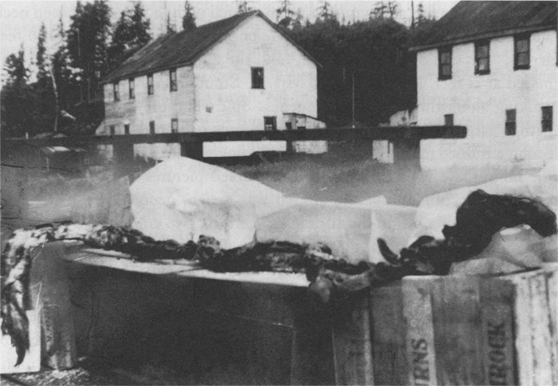
The Naden Harbor (British Columbia) “Cadborosaurus” carcass, retrieved from the stomach of a sperm whale and photographed in October, 1937. The specimen has since been lost.
Cadborosaurus willsi, nicknamed Caddy, is an alleged sea serpent reported to be living on the Pacific Coast of North America. Its name is derived from Cadboro Bay in Victoria, British Columbia, and the Greek root word “saurus” meaning lizard or reptile. Reports describe it as being similar in form and behavior to various popularly named lake monsters such as Ogopogo of Okanagan Lake in British Columbia, Cassie of the Casco Bay of the Gulf of Maine, the Gloucester Sea Serpent off Boston and Cape Ann, Massachusetts, and Chessie of Chesapeake Bay, Virginia-Maryland. (BTW, I think Caddy and the other Sea Serpents in this list are mammals, not reptiles.)
There have been more than 300 claimed sightings of Caddy during the past 200 years, including Deep Cove in Saanich Inlet, and Island View Beach, both like Cadboro Bay also on the Saanich Peninsula, also British Columbia, and also at San Francisco Bay, California.
In 2009, artist Lee Murphy created for the International Cryptozoology Museum, a full-scale model of the Naden Harbor carcass.
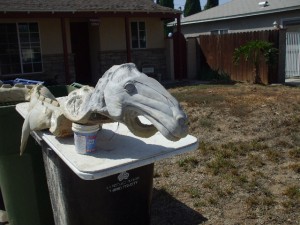
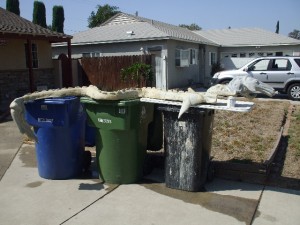
Due to the specific size of the model, the museum has been unable to fully display it. That is all going to change with the move to our new larger space in 45 days.
Therefore, we are researching what exactly the carcass is sitting on, so as to obtain wooden crates of the same size and configuration. Any information anyone has on these crates would be appreciated.
What is the body of this dead sea serpent resting on, anyway?
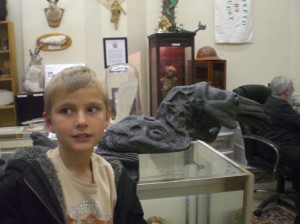
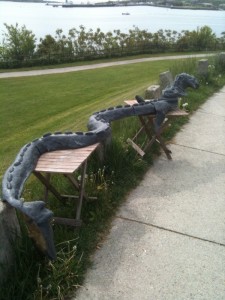

Director of Docents Jeff Meuse shows the scale of the ICM’s Caddy carcass replica.
About Loren Coleman
Loren Coleman is one of the world’s leading cryptozoologists, some say “the” leading living cryptozoologist. Certainly, he is acknowledged as the current living American researcher and writer who has most popularized cryptozoology in the late 20th and early 21st centuries.
Starting his fieldwork and investigations in 1960, after traveling and trekking extensively in pursuit of cryptozoological mysteries, Coleman began writing to share his experiences in 1969. An honorary member of Ivan T. Sanderson’s Society for the Investigation of the Unexplained in the 1970s, Coleman has been bestowed with similar honorary memberships of the North Idaho College Cryptozoology Club in 1983, and in subsequent years, that of the British Columbia Scientific Cryptozoology Club, CryptoSafari International, and other international organizations. He was also a Life Member and Benefactor of the International Society of Cryptozoology (now-defunct).
Loren Coleman’s daily blog, as a member of the Cryptomundo Team, served as an ongoing avenue of communication for the ever-growing body of cryptozoo news from 2005 through 2013. He returned as an infrequent contributor beginning Halloween week of 2015.
Coleman is the founder in 2003, and current director of the International Cryptozoology Museum in Portland, Maine.










I can’t offer any info on what the caddie is resting on, but I can state that that is an absolutely beautiful model. Whoever did that is really good.
The carcass is lying on a kitchen table in the middle and supported on either side with crates that we believe are from a now defunct salmon company. They certainly look like salmon crates that we have out here in British Columbia.
Is the image of the original Caddy photo cropped from a larger picture? If there is an image that shows more of the crates it may make reading the printing on the containers possible and an ID of the type, size and construction material much easier.
I found a picture of the tail. It does show the entire crate, all it says on the side is Shamrock though. Hopefully it is helpful to somebody.
Well there was a Shamrock salmon label so it is quite possible that they are salmon crates as suggested; I do not know the dimensions of salmon crates but this photo:
shows a couple of salmon crates in proximity to men to get some idea, they look fairly large.
Fish crates without a doubt, and the “head” of the beast is lying on a hunk of ice. The large blocky objects behind the remains are blocks of ice which, interestingly, would have been harvested from a freshwater lake in winter and stored in an icehouse through the summer covered with straw and tarps. The freshly caught fish would be packed in the crates after cleaning along with ground up ice similar in consistency to snow.
My grandfather, and his father before him, were fishermen on the Great Lakes, so my observations may not directly translate to the Pacific North West, but the crates as I recall, were made of cedar and the wood was quite thin, something less than 1/2 inch I would say and the crates were overall about 3 feet by 1-1/2 feet by 5 or 6 inches deep.
My comment is in relation to the Cadborosaurus Willsi, or “Caddy”, and the discussion concerning size of the wooden crates the specimen is placed on, as a determining factor to calculate the dimensions of the creature.
I am familiar with wooden crates, having an interest in antiques and collectables and the crates marked “shamrock” are most certainly orange crates. The size of those crates in the photo, from 1912 to the early 1940’s (that I know for sure but could be earlier and later than this range as well) was 26 inches by 12 inches, Length by Width on the top opening of the crate, and 12 inches in Depth, usually with a vertical divider at the midpoint of the opening that extended to the top of the crate to prevent contents from shifting during transport.
I will make measurements, as best I can, based on the known dimensions of the Shamrock crate, specifically the visible edge with the name painted on it being 26 inches in length.
I hope this is helpful, and I will post my measurements as soon as I complete them! Maybe others could make the same calculations for comparison with mine, just for verification purposes.
These measurements could be important in determining what it is if, in fact, a viable candidate for comparison should arise!